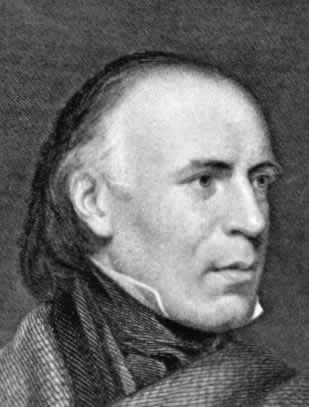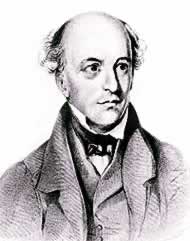Think that you may own a portrait of Allan Cunningham? We authenticate, appraise and issue Certificates of Authenticity (COA) for all portraits of Allan Cunningham.

Portrait of Allan Cunningham, artist unknown
Allan Cunningham was an English botanist and explorer, primarily known for his travels in New South Wales to collect plants. Cunningham was born in Wimbledon, Surrey. His father, Allan Cunningham, came from Renfrewshire, Scotland, his mother was English. He was well educated at a private school at Putney and then went into a solicitor's office. He afterwards obtained a position with W. T. Aiton superintendent of Kew Gardens, and this brought him in touch with Robert Brown and Sir Joseph Banks.
On Banks' recommendation, he went to Brazil between 1814 and 1816 collecting specimens. On 28 September 1816 he sailed for Sydney where he arrived on 20 December 1816. He established himself at Parramatta. Among other explorations, he joined John Oxley's 1817 expedition beyond the Blue Mountains to the Lachlan and Macquarie rivers and shared in the privations of the 1200 miles (1930 km) journey. He was able to collect specimens of about 450 species and gained valuable experience as an explorer. He also climbed Mount Keira.

Portrait of Allan Cunningham, artist unknown 1835
He traveled as the ship's botanist aboard HMS Mermaid under Phillip Parker King from 1817 to 1820. The Mermaid, was of only 85 tons, but sailing on 22 December 1817 they reached King George's Sound on 21 January 1818. Though their stay was short many interesting specimens were found, but the islands on the west coast were comparatively barren. Towards the end of March the Goulburn Islands on the north coast were reached, and there many new plants were discovered. They reached Timor on 4 June 1818 and turning for home arrived at Port Jackson on 29 July 1818. Cunningham's collections during this voyage included about 300 species.
Shortly after his return he made an excursion in the country southerly from Sydney, and towards the end of the year he made a voyage to Tasmania arriving at Hobart on 2 January 1819. He next visited Launceston, Tasmania and though often finding the botany interesting, he found little that was absolutely new, as Brown had preceded him. In May he went with King in the Mermaid on a second voyage to the north and north-west coasts. On this occasion they started up the east coast and Cunningham found many opportunities for adding to his collections. The circumnavigation of Australia was completed on 27 August when they reached Vernon Island in Clarence Strait. They again visited Timor and arrived back in Sydney on 12 January 1820. The third voyage to the north coast with King began on 15 June, but meeting bad weather the bowsprit was lost and a return was made for repairs. Sailing again on 13 July 1820 the northerly course was followed and eventually the continent was circumnavigated. Though they found the little vessel was in a bad state when they were on the north-west coast, and though serious danger was escaped until they were close to home, they were nearly wrecked off Botany Bay. The Mermaid was then condemned and the next voyage was on the Bathurst which was twice the size of the Mermaid. They left on 26 May 1821, the northern route was chosen, and when they were on the west coast of Australia it was found necessary to go to Mauritius to refit, where they arrived on 27 September 1821. They left after a stay of seven weeks and reached King George's Sound on 24 December 1821. A sufficiently long stay was made for Cunningham to make an excellent collection of plants, and then turning on their tracks the Bathurst sailed up the west coast and round the north of Australia. Sydney was reached again on 25 April 1822. Cunningham's A Few General Remarks on the Vegetation of Certain Coasts of Terra Australis, will be found in King's Narrative of a Survey, etc.

Engraved Portrait of Allan Cunningham, artist unknown
In September 1822 Cunningham went on an expedition over the Blue Mountains and arrived at Bathurst on 14 October 1822 and returned to Parramatta in January 1823. His account of about 100 plants met with will be found in Geographical Memoirs on New South Wales, edited by Barron Field, 1825, under the title "A Specimen of the Indigenous Botany . . . between Port Jackson and Bathurst".
In 1823, with five men and five horses, he set out from Bathurst, New South Wales to explore from the Cudgegong River as far as Liverpool Plains. He examined the Cudgegong and Goulburn Rivers. On June 2, he discovered Pandora's Pass opening out a fair and practicable road to Liverpool Plains. He returned to Bathurst by the Cudgegong on 27 June 1823.
He also undertook an expedition to what is now Canberra in 1824. He travelled with three convicts, three horses and a cart and he travelled via Lake bathurst, Captains Flat and the valley in which flows the Queanbeyan River. Poor weather prevented him from continuing his journey south.
Cunningham had long wished to visit New Zealand and on 28 August 1826 he was able to sail on a whaler. He was hospitably received by the missionaries in the Bay of Islands, was able to do much botanical work, and returned to Sydney on 20 January 1827. Accounts of his work in New Zealand will be found in Hooker's Companion to the Botanical Magazine, 1836, and Annals of Natural History, 1838 and 1839.
In 1827 Cunningham set out from the upper Hunter River to explore inside the Great Dividing Range, discovering the Darling Downs. Cunningham was to return in 1828 from Brisbane to discover Cunningham's Gap. Cunningham travelled on the right hand side of the Gap whereas the highway today runs on the lefthand side from the small township of Aratula. Spicer's Gap which runs parallel to Cunningham's Gap was used in coaching days. The peaks on either side of the gap were also named, Mount Cordeaux and Mount Mitchell. In 1829 he explored the Brisbane River.
Cunningham was chosen by Joseph Banks to travel abroad to collect plants for the Royal Botanic Gardens, Kew. In 1831 he returned to England, but went back to Australia as Government Botanist in 1837, resigning in the following year finding that he was required to grow vegetables for government officials. He died in Sydney on 27 June 1839, his grave is in the Royal Botanic Gardens Sydney.
Cunningham was a modest man of fine character. He was an indefatigable worker as a botanist, and scarcely had time between his journeys to give evidence of his scientific powers, though a few of his papers will be found in journals of the period. His immense collections of specimens mostly went to Kew Gardens and eventually to the British museum. He also takes high rank among Australian explorers, for though his parties were small in number and comparatively poorly equipped, his courage, resourcefulness, and knowledge, enabled him to achieve what he set out to do, and his journeys opened up much country for settlement.
Still wondering about a portrait in your family collection? Contact us... it could be a portrait of Allan Cunningham.
